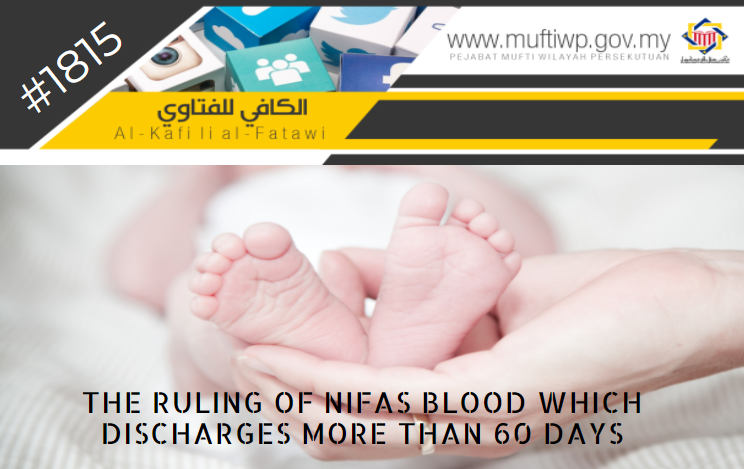
Question:
Assalamualaikum wbt. If the nifas blood discharges from a woman exceeding 60 days, is it considered istihadhah?
Brief Answer:
- If the blood flows continuously and does not stop even for one second, then it is ruled as istihadhah by considering one of the characteristics of istihadhah.
- If the blood stops even for one second so the blood discharges after that are ruled as haid.
Explanation:
Waalaikumussalam wrm. Wbt. Alhamdulillah, praise and thanks to Allah for the countless blessings He has blessed us all with. Blessings and salutations to the Prophet Muhammad PBUH, his wives, his family, companions and all those that follow his teachings to the day of judgement.
THE MEANING OF NIFAS
Nifas is the blood that discharges after the womb is free from any foetus even in the form of alaqah (a clot of blood) or mudghah (a piece of meat), and before the least period of pure (after giving birth) which is for 15 days. If a person sees blood after 15 days of giving birth and above, then it is not considered as nifas. (Refer: Hasyiyah Qalyubi, 1/112).
This is as mentioned by Imam Ibn Hajar al-Haitami:
Nifas is the blood that discharges after the womb is clear from the foetus even in the form of alaqah (a clot of blood) or mudghah (a piece of meat), and before the least period of pure (after giving birth) which is for 15 days. If a person sees blood after 15 days of giving birth. (Refer: Ibn Hajar al-Haitami, Tuhfah al-Muhtaj, 1/383).
THE PERIOD OF NIFAS
Ibn Hajar al-Haitami mentions the period for nifas:
There is no minimum period for nifas, in other words, unmeasurable, it is seen as what is there, even if the nifas is very little, but the appropriate amount for the minimum period is one second. And the longest period of nifas is 60 days, and the normal period is 40 days, which is gotten through istiqra’ (research) as mentioned. (Refer: Ibn Hajar al-Haitami, Tuhfah al-Muhtaj, 1/413).
Hence, we may conclude here that the period for nifas is as the following:
- Minimum period: one second
- Maximum period: 60 days
- Normal period: 40 days
Therefore, it is clear that the maximum period for a woman to experience nifas is 60 days. If the blood discharge exceeds 60 days, then the ruling is as the following:
- If the blood flows continuously and does not stop even for one second, then it is ruled as istihadhah by considering one of the characteristics of istihadhah.
- If the blood stops even for one second so the blood discharges after that are ruled as haid. (Refer: al-Ibanah wa al-Ifadhah,36).
Wallahu a’lam.